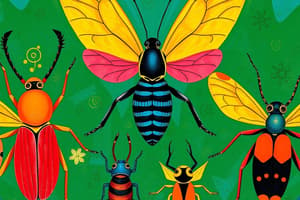Podcast
Questions and Answers
What is the primary function of the spiracles in insects?
What is the primary function of the spiracles in insects?
- To store oxygen for metabolic processes.
- To regulate air passage and minimize water loss. (correct)
- To provide structure and support to the respiratory system.
- To facilitate movement through the water.
How many pairs of spiracles are functional in a hypopneustic respiratory system?
How many pairs of spiracles are functional in a hypopneustic respiratory system?
- 5 functional pairs and 5 non-functional pairs.
- 10 functional pairs, all operational.
- 7 functional pairs and 3 non-functional pairs. (correct)
- 9 functional pairs and 1 non-functional pair.
What distinguishes tracheae from tracheoles in insects?
What distinguishes tracheae from tracheoles in insects?
- Tracheae are less permeable to gases than tracheoles.
- Tracheae are larger in diameter than tracheoles. (correct)
- Tracheoles contact respiring tissues, while tracheae do not.
- Tracheae only transport carbon dioxide, whereas tracheoles transport oxygen.
Which insect respiratory classification has no functional spiracles?
Which insect respiratory classification has no functional spiracles?
What structural feature of tracheae allows them to maintain flexibility while resisting compression?
What structural feature of tracheae allows them to maintain flexibility while resisting compression?
What is the primary role of airsacs in insects?
What is the primary role of airsacs in insects?
In the closed tracheal system of aquatic insects, what is the function of the tracheae network covering the body surface?
In the closed tracheal system of aquatic insects, what is the function of the tracheae network covering the body surface?
Which mechanism primarily drives the entry of oxygen into the tracheal system?
Which mechanism primarily drives the entry of oxygen into the tracheal system?
What is the role of the respiratory siphon in aquatic insects?
What is the role of the respiratory siphon in aquatic insects?
Which structure acts as a physical gill in some aquatic insects?
Which structure acts as a physical gill in some aquatic insects?
Flashcards
Insect Tracheal System
Insect Tracheal System
Network of gas-filled tubes for respiration where air is delivered directly to tissues, and hemolymph does not have a respiratory role.
Tracheoles
Tracheoles
Finest branches of the trachea that are in contact with internal organs and tissues, facilitating gas exchange.
Spiracles
Spiracles
Openings on the insect's body (up to ten pairs) that allow air to enter the tracheal system.
Atrial Valve
Atrial Valve
Signup and view all the flashcards
Taenidia
Taenidia
Signup and view all the flashcards
Airsacs
Airsacs
Signup and view all the flashcards
Holopneustic
Holopneustic
Signup and view all the flashcards
Amphipneustic
Amphipneustic
Signup and view all the flashcards
Apneustic
Apneustic
Signup and view all the flashcards
Closed Tracheal System
Closed Tracheal System
Signup and view all the flashcards
Study Notes
Respiration in Insects
- Insects need oxygen and expel carbon dioxide like other aerobic organisms
- This is done through a network of gas-filled tubes
- Air is delivered directly to tissues
- Hemolymph (blood) does not have a respiratory role
- Gas exchange occurs in tracheae
Tracheae
- These tubes branch throughout the insect's body
- Tracheoles are the finest branches and are in contact with internal organs and tissues
- Tracheoles are numerous in tissues with high oxygen demands
- Air enters the tracheae through spiracles
- There are up to ten pairs of spiracles (located on the body's sides)
- Each spiracle has an opening and closing mechanism called an atrial valve that regulates air passage and reduces water loss
- Tracheae are invaginations of the epidermis, meaning their lining is connected to the body's outermost layer
- Tracheae have a ring-like appearance due to spiral ridges called taenidia
- Taenidia add flexibility and prevent compression
- Tracheal linings are shed during molting
- Tracheoles are less than 1 µm in diameter
- Tracheoles do not have taenidia or a wax layer
- Tracheoles are permeable to gases
- Tracheoles are intracellular in nature
- Gas exchange occurs in tracheoles
- Tracheal trunks help transport air (lateral, dorsal, ventral, and visceral)
- Airsacs are thin-walled, collapsible sacs that act as oxygen reservoirs
- Airsacs are responsible for providing buoyancy to flying and aquatic insects, providing space for growing organs, sound resonance, and heat insulation
Respiratory System Classifications
- Holopneustic: Ten pairs of spiracles (two thoracic and eight abdominal)
- Hemipneustic: One or two non-functional pairs out of ten
- Peripneustic: Nine pairs of spiracles (one thoracic and eight abdominal)
- Amphipneustic: Two pairs of spiracles (one anterior, one posterior)
- Propneustic: One pair of anterior spiracles
- Metapneustic: One pair of posterior spiracles
- Hypopneustic: Seven functional spiracles (one thoracic and six abdominal) and three non-functional spiracles
- Apneustic: All spiracles are closed, closed tracheal system
Respiration in Aquatic Insects
- Closed Tracheal System:
- Spiracles are absent
- Tracheae branch out to form a network over the body surface
- Allows for cutaneous gas exchange
- Examples: Gills (tracheated thin outgrowth of body wall), lamellate gills (mayfly naiad), filamentous gills (damselfly naiad), rectal gills (dragonfly naiad)
- Open Tracheal System:
- Air store: Air bubble stored under wings acts as a physical gill (e.g., water bug)
- Respiratory siphon: (e.g., wriggler)
- Caudal breathing tube: (e.g., water scorpion)
- Plastron: Closely set hydrofuge hairs hold a thin film of air indefinitely
Studying That Suits You
Use AI to generate personalized quizzes and flashcards to suit your learning preferences.




